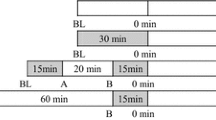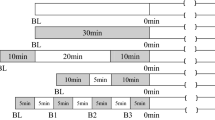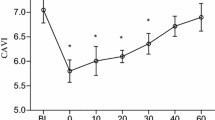Abstract
Purpose
To examine and compare systemic arterial stiffness responses in humans to acute continuous and interval low-intensity exercise.
Methods
Fifteen healthy young men (21.2 ± 0.4 years) underwent non-exercise control (CON), continuous exercise (CE), and interval exercise trial (IE) in a randomized balanced self-control crossover design. Systemic arterial stiffness (Cardio-ankle vascular index, CAVI) was measured at baseline (BL), immediately after (0 min) and 40 min after exercise in CE and IE trials, and at corresponding time points in CON trial. Subjects cycled continuously for 30 min at 35 % heart rate reserve after BL measurement in CE trial, whereas in IE trial, subjects cycled two bouts of 15-min separated by a 20-min rest at the same intensity.
Results
There were no significant CAVI changes with time in CON trial (6.7 ± 0.1, 6.7 ± 0.1, 6.6 ± 0.1 at BL, 0 and 40 min, respectively). In CE trial, CAVI decreased immediately after exercise (0 min) and returned to baseline after 40 min of recovery (6.5 ± 0.1, 5.5 ± 0.2, 6.4 ± 0.1 at BL, 0 and 40 min, respectively). IE elicited similar CAVI reduction from 6.7 ± 0.1 at baseline to 5.6 ± 0.2 at 0 min: however, CAVI at 40 min remained significantly low compared to that of CON trial at corresponding time point (6.0 ± 0.1 vs. 6.6 ± 0.1, P < 0.001).
Conclusion
Both acute continuous and interval low-intensity exercise elicits transient improvement in systemic arterial stiffness in humans. Despite equivalent exercise intensity and duration, interval exercise resulted in improved arterial stiffness for longer duration.



Similar content being viewed by others
Abbreviations
- baPWV:
-
Brachial-ankle pulse wave velocity
- BL:
-
Baseline
- BMI:
-
Body mass index
- BP:
-
Blood pressure
- CAVI:
-
Cardio-ankle vascular index
- CE:
-
Continuous exercise
- CON:
-
Control
- DIA:
-
Diastolic blood pressure
- HIT:
-
High-intensity interval training
- HRR:
-
Heart rate reserve
- IE:
-
Interval exercise
- LB:
-
Left brachial
- RB:
-
Right brachial
- SYS:
-
Systolic blood pressure
References
Altena TS, Michaelson JL, Ball SD, Thomas TR (2004) Single sessions of intermittent and continuous exercise and postprandial lipemia. Med Sci Sports Exerc 36(8):1364–1371
Ando T, Usui C, Ohkawara K, Miyake R, Miyashita M, Park J, Ezaki O, Higuchi M, Tanaka S (2013) Effects of intermittent physical activity on fat utilization over a whole day. Med Sci Sports Exerc 45(7):1410–1418. doi:10.1249/MSS.0b013e3182885e4b
Aoi W, Yamauchi H, Iwasa M, Mune K, Furuta K, Tanimura Y, Wada S, Higashi A (2013) Combined light exercise after meal intake suppresses postprandial serum triglyceride. Med Sci Sports Exerc 45(2):245–252. doi:10.1249/MSS.0b013e31826f3107
Buchheit M, Laursen PB (2013) High-intensity interval training, solutions to the programming puzzle: part I: cardiopulmonary emphasis. Sports Med (Auckland, NZ) 43(5):313–338. doi:10.1007/s40279-013-0029-x
Chen TC, Chen HL, Pearce AJ, Nosaka K (2012) Attenuation of eccentric exercise-induced muscle damage by preconditioning exercises. Med Sci Sports Exerc 44(11):2090–2098. doi:10.1249/MSS.0b013e31825f69f3
Ciolac EG, Guimaraes GV, D Avila VM, Bortolotto LA, Doria EL, Bocchi EA (2009) Acute effects of continuous and interval aerobic exercise on 24-h ambulatory blood pressure in long-term treated hypertensive patients. Int J Cardiol 133(3):381–387. doi:10.1016/j.ijcard.2008.02.005
Coquart JB, Lemaire C, Dubart AE, Luttembacher DP, Douillard C, Garcin M (2008) Intermittent versus continuous exercise: effects of perceptually lower exercise in obese women. Med Sci Sports Exerc 40(8):1546–1553. doi:10.1249/MSS.0b013e31816fc30c
Eriksen L, Dahl-Petersen I, Haugaard SB, Dela F (2007) Comparison of the effect of multiple short-duration with single long-duration exercise sessions on glucose homeostasis in type 2 diabetes mellitus. Diabetologia 50(11):2245–2253. doi:10.1007/s00125-007-0783-0
Forjaz CL, Tinucci T, Ortega KC, Santaella DF, Mion D Jr, Negrao CE (2000) Factors affecting post-exercise hypotension in normotensive and hypertensive humans. Blood Press Monit 5(5–6):255–262
Forjaz CL, Cardoso CG Jr, Rezk CC, Santaella DF, Tinucci T (2004) Postexercise hypotension and hemodynamics: the role of exercise intensity. J Sports Med Phys Fit 44(1):54–62
Garber CE, Blissmer B, Deschenes MR, Franklin BA, Lamonte MJ, Lee IM, Nieman DC, Swain DP (2011) American College of Sports Medicine position stand. Quantity and quality of exercise for developing and maintaining cardiorespiratory, musculoskeletal, and neuromotor fitness in apparently healthy adults: guidance for prescribing exercise. Med Sci Sports Exerc 43(7):1334–1359. doi:10.1249/MSS.0b013e318213fefb
Goto K, Ishii N, Mizuno A, Takamatsu K (2007) Enhancement of fat metabolism by repeated bouts of moderate endurance exercise. J Appl Physiol 102(6):2158–2164
Guimaraes GV, Ciolac EG, Carvalho VO, D’Avila VM, Bortolotto LA, Bocchi EA (2010) Effects of continuous vs. interval exercise training on blood pressure and arterial stiffness in treated hypertension. Hypertens Res 33(6):627–632. doi:10.1038/hr.2010.42
Halliwill JR (2001) Mechanisms and clinical implications of post-exercise hypotension in humans. Exerc Sport Sci Rev 29(2):65–70
Haskell WL, Lee IM, Pate RR, Powell KE, Blair SN, Franklin BA, Macera CA, Heath GW, Thompson PD, Bauman A (2007) Physical activity and public health: updated recommendation for adults from the American College of Sports Medicine and the American Heart Association. Circulation 116(9):1081–1093
Heffernan KS, Jae SY, Echols GH, Lepine NR, Fernhall B (2007) Arterial stiffness and wave reflection following exercise in resistance-trained men. Med Sci Sports Exerc 39(5):842–848
Hu Q, Zhu W, Zhu Y, Zheng L, Hughson RL (2012) Acute effects of warm footbath on arterial stiffness in healthy young and older women. Eur J Appl Physiol 112(4):1261–1268. doi:10.1007/s00421-011-2066-1
Ibata J, Sasaki H, Kakimoto T, Matsuno S, Nakatani M, Kobayashi M, Tatsumi K, Nakano Y, Wakasaki H, Furuta H, Nishi M, Nanjo K (2008) Cardio-ankle vascular index measures arterial wall stiffness independent of blood pressure. Diabetes Res Clin Pract 80(2):265–270. doi:10.1016/j.diabres.2007.12.016S0168-8227(07)00660-2
Jones H, George K, Edwards B, Atkinson G (2007) Is the magnitude of acute post-exercise hypotension mediated by exercise intensity or total work done? Eur J Appl Physiol 102(1):33–40. doi:10.1007/s00421-007-0562-0
Jones H, Taylor CE, Lewis NC, George K, Atkinson G (2009) Post-exercise blood pressure reduction is greater following intermittent than continuous exercise and is influenced less by diurnal variation. Chronobiol Int 26(2):293–306. doi:10.1080/07420520902739717
Kingwell BA, Berry KL, Cameron JD, Jennings GL, Dart AM (1997) Arterial compliance increases after moderate-intensity cycling. Am J Physiol 273(5 Pt 2):H2186–2191
Manders RJ, Van Dijk JW, van Loon LJ (2010) Low-intensity exercise reduces the prevalence of hyperglycemia in type 2 diabetes. Med Sci Sports Exerc 42(2):219–225. doi:10.1249/MSS.0b013e3181b3b16d
Mc Clean CM, Mc Laughlin J, Burke G, Murphy MH, Trinick T, Duly E, Davison GW (2007) The effect of acute aerobic exercise on pulse wave velocity and oxidative stress following postprandial hypertriglyceridemia in healthy men. Eur J Appl Physiol 100(2):225–234
Murtagh EM, Boreham CA, Nevill A, Hare LG, Murphy MH (2005) The effects of 60 minutes of brisk walking per week, accumulated in two different patterns, on cardiovascular risk. Prev Med 41(1):92–97. doi:10.1016/j.ypmed.2004.10.008
Naka KK, Tweddel AC, Parthimos D, Henderson A, Goodfellow J, Frenneaux MP (2003) Arterial distensibility: acute changes following dynamic exercise in normal subjects. Am J Physiol Heart Circ Physiol 284(3):H970–H978
Paraskevaidis IA, Iliodromitis EK, Mavrogeni S, Karavolias GK, Theodorakis GN, Georgiadis M, Kremastinos DT (2005) Repeated exercise stress testing identifies early and late preconditioning. Int J Cardiol 98(2):221–226. doi:10.1016/j.ijcard.2003.10.040
Park S, Rink LD, Wallace JP (2006) Accumulation of physical activity leads to a greater blood pressure reduction than a single continuous session, in prehypertension. J Hypertens 24(9):1761–1770
Ronsen O, Kjeldsen-Kragh J, Haug E, Bahr R, Pedersen BK (2002) Recovery time affects immunoendocrine responses to a second bout of endurance exercise. Am J Physiol Cell Physiol 283(6):C1612–C1620. doi:10.1152/ajpcell.00242.2002
Shirai K, Utino J, Otsuka K, Takata M (2006) A novel blood pressure-independent arterial wall stiffness parameter; cardio-ankle vascular index (CAVI). J Atheroscler Thromb 13(2):101–107 [pii] JST.JSTAGE/jat/13.101
Stevenson JS, Topp R (1990) Effects of moderate and low intensity long-term exercise by older adults. Res Nurs Health 13(4):209–218
Sugawara J, Otsuki T, Tanabe T, Maeda S, Kuno S, Ajisaka R, Matsuda M (2003) The effects of low-intensity single-leg exercise on regional arterial stiffness. Jpn J Physiol 53(3):239–241
Sugawara J, Inoue H, Hayashi K, Yokoi T, Kono I (2004a) Effect of low-intensity aerobic exercise training on arterial compliance in postmenopausal women. Hypertens Res 27(12):897–901
Sugawara J, Maeda S, Otsuki T, Tanabe T, Ajisaka R, Matsuda M (2004b) Effects of nitric oxide synthase inhibitor on decrease in peripheral arterial stiffness with acute low-intensity aerobic exercise. Am J Physiol Heart Circ Physiol 287(6):H2666–H2669
Tabara Y, Yuasa T, Oshiumi A, Kobayashi T, Miyawaki Y, Miki T, Kohara K (2007) Effect of acute and long-term aerobic exercise on arterial stiffness in the elderly. Hypertens Res 30(10):895–902 JST.JSTAGE/hypres/30.895
Terblanche E, Millen AM (2012) The magnitude and duration of post-exercise hypotension after land and water exercises. Eur J Appl Physiol 112(12):4111–4118. doi:10.1007/s00421-012-2398-5
Thompson PD, Crouse SF, Goodpaster B, Kelley D, Moyna N, Pescatello L (2001) The acute versus the chronic response to exercise. Med Sci Sports Exerc 33(6 Suppl):S438–S445 discussion S452-S433
Tordi N, Mourot L, Colin E, Regnard J (2010) Intermittent versus constant aerobic exercise: effects on arterial stiffness. Eur J Appl Physiol 108(4):801–809. doi:10.1007/s00421-009-1285-1
Wallace JP, Bogle PG, King BA, Krasnoff JB, Jastremski CA (1999) The magnitude and duration of ambulatory blood pressure reduction following acute exercise. J Hum Hypertens 13(6):361–366
Willie CK, Ainslie PN, Taylor CE, Eves ND, Tzeng YC (2013) Maintained cerebrovascular function during post-exercise hypotension. Eur J Appl Physiol 113(6):1597–1604. doi:10.1007/s00421-012-2578-3
Acknowledgments
This study was supported by National Natural Science Foundation of China (31371206), Science and Technology Development Program of Beijing Municipal Commission of Education (KM201310029003), and Beijing Key Lab Funding (2011BJKL-01).
Author information
Authors and Affiliations
Corresponding author
Additional information
Communicated by Massimo Pagani.
H. Wang and T. Zhang contributed equally to this study.
Rights and permissions
About this article
Cite this article
Wang, H., Zhang, T., Zhu, W. et al. Acute effects of continuous and interval low-intensity exercise on arterial stiffness in healthy young men. Eur J Appl Physiol 114, 1385–1392 (2014). https://doi.org/10.1007/s00421-014-2869-y
Received:
Accepted:
Published:
Issue Date:
DOI: https://doi.org/10.1007/s00421-014-2869-y




